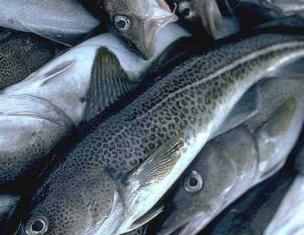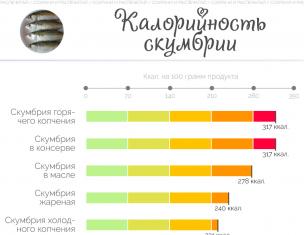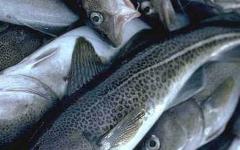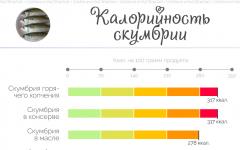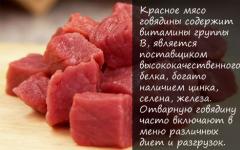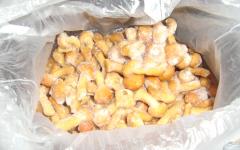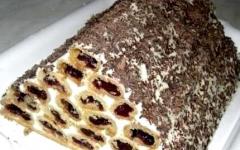CHEMICAL COMPOSITION AND NUTRITIONAL ANALYSIS
Nutritional value and chemical composition "Boiled cod, 1-340 each".
The table shows the nutritional content (calories, proteins, fats, carbohydrates, vitamins and minerals) per 100 grams of edible portion.
| Nutrient | Quantity | Norm** | % of the norm in 100 g | % of the norm in 100 kcal | 100% normal |
| Calorie content | 79 kcal | 1684 kcal | 4.7% | 5.9% | 2132 g |
| Squirrels | 17.9 g | 76 g | 23.6% | 29.9% | 425 g |
| Fats | 0.8 g | 56 g | 1.4% | 1.8% | 7000 g |
| Water | 78.8 g | 2273 g | 3.5% | 4.4% | 2885 g |
| Ash | 2.5 g | ~ | |||
| Vitamins | |||||
| Vitamin A, RE | 10 mcg | 900 mcg | 1.1% | 1.4% | 9000 g |
| Retinol | 0.01 mg | ~ | |||
| Vitamin B1, thiamine | 0.07 mg | 1.5 mg | 4.7% | 5.9% | 2143 g |
| Vitamin B2, riboflavin | 0.05 mg | 1.8 mg | 2.8% | 3.5% | 3600 g |
| Vitamin C, ascorbic acid | 0.6 mg | 90 mg | 0.7% | 0.9% | 15000 g |
| Vitamin E, alpha tocopherol, TE | 1.1 mg | 15 mg | 7.3% | 9.2% | 1364 g |
| Vitamin RR, NE | 6.4 mg | 20 mg | 32% | 40.5% | 313 g |
| Niacin | 2 mg | ~ | |||
| Macronutrients | |||||
| Potassium, K | 233 mg | 2500 mg | 9.3% | 11.8% | 1073 g |
| Calcium, Ca | 33 mg | 1000 mg | 3.3% | 4.2% | 3030 g |
| Magnesium, Mg | 24 mg | 400 mg | 6% | 7.6% | 1667 g |
| Sodium, Na | 671 mg | 1300 mg | 51.6% | 65.3% | 194 g |
| Phosphorus, Ph | 181 mg | 800 mg | 22.6% | 28.6% | 442 g |
| Microelements | |||||
| Iron, Fe | 0.7 mg | 18 mg | 3.9% | 4.9% | 2571 g |
| Sterols (sterols) | |||||
| Cholesterol | 44 mg | max 300 mg | |||
| Saturated fatty acids | |||||
| Saturated fatty acids | 0.1 g | max 18.7 g |
Energy value Boiled cod, 1-340 each is 79 kcal.
Main source: Skurikhin I.M. and others. Chemical composition of food products. .
** This table shows the average levels of vitamins and minerals for an adult. If you want to know the norms taking into account your gender, age and other factors, then use the My Healthy Diet app.
Product calculator
The nutritional value
Serving Size (g)
NUTRIENT BALANCE
Most foods may not contain the full range of vitamins and minerals. Therefore, it is important to eat a variety of foods to meet the body's needs for vitamins and minerals.
Product calorie analysis
SHARE OF BZHU IN CALORIES
Ratio of proteins, fats and carbohydrates:
Knowing the contribution of proteins, fats and carbohydrates to calorie content, you can understand how well a product or diet meets the standards of a healthy diet or the requirements of a certain diet. For example, the US and Russian Departments of Health recommend 10-12% of calories come from protein, 30% from fat and 58-60% from carbohydrates. The Atkins diet recommends low carbohydrate intake, although other diets focus on low fat intake.
If more energy is expended than it is received, the body begins to use up fat reserves, and body weight decreases.
Try filling out your food diary right now without registration.
Find out your additional calorie expenditure for training and get updated recommendations absolutely free.
DATE FOR ACHIEVEMENT OF THE GOAL
USEFUL PROPERTIES OF BOILED COD, 1-340 each
Boiled cod, 1-340 each rich in vitamins and minerals such as: vitamin PP - 32%, phosphorus - 22.6%
Benefits of boiled cod, 1-340 each
- Vitamin PP participates in redox reactions of energy metabolism. Insufficient vitamin intake is accompanied by disruption of the normal condition of the skin, gastrointestinal tract and nervous system.
- Phosphorus takes part in many physiological processes, including energy metabolism, regulates acid-base balance, is part of phospholipids, nucleotides and nucleic acids, and is necessary for the mineralization of bones and teeth. Deficiency leads to anorexia, anemia, and rickets.
The nutritional value- content of carbohydrates, fats and proteins in the product.
Nutritional value of food product- a set of properties of a food product, the presence of which satisfies the physiological needs of a person for the necessary substances and energy.
Vitamins, organic substances required in small quantities in the diet of both humans and most vertebrates. Vitamin synthesis is usually carried out by plants, not animals. A person's daily requirement for vitamins is only a few milligrams or micrograms. Unlike inorganic substances, vitamins are destroyed by strong heat. Many vitamins are unstable and are “lost” during cooking or food processing.
Cod is a marine fish of the cod family. It has a greenish-brown color with brown spots and a white belly.
The size of cod depends on its age: the length reaches 1.8 - 2 meters, while the weight of the fish caught ranges from 4 - 12 kilograms.  This fish has a barbel on the chin, three dorsal and two ventral fins without spiny rays, movable premaxillary and maxillary bones. Its scales are cycloid and its gills are comb-like.
This fish has a barbel on the chin, three dorsal and two ventral fins without spiny rays, movable premaxillary and maxillary bones. Its scales are cycloid and its gills are comb-like.
In terms of the structure of the fins, representatives of the cod-like family are similar to the Cyprinidae, and in the position of the ventral fins, they are similar to the Perciformes.
Historical information
Cod has played an important role in the history of Europe and America for more than a thousand years. The Vikings who lived on the Lofoten Islands ate dried fish. Immediately after the catch, it was hung in an open, well-ventilated area; after three months, the carcasses were beaten until the meat became soft and edible. Such nutritious food was stored for a long time, which was ideal for a wandering tribe.
Fish then gained popularity in Europe for religious reasons: unlike meat, it could be eaten during Lent.
Between 1958 and 1976, a diplomatic conflict arose over cod. The controversy stemmed from the first state's imposition of a 200-mile economic zone around the island, which prohibited fishing in Icelandic waters where British fishermen were casting their nets.
Interestingly, the maximum weight of the largest cod caught in history was 96 kilograms.
Characteristic
The fish's habitat covers the Atlantic Ocean (Baltic, White Sea, Arctic cod). In the east of the Atlantic it is distributed from Spitsbergen and the Barents Sea to the Bay of Biscay, in the west - from Greenland to Cape Hatteras. In particular, it lives in the Norwegian Sea, the Pacific Ocean, and off the coast of Iceland. Interestingly, only two types of fish are most often found under the trade name cod - Pacific and Atlantic. Baltic, White Sea, and Greenlandic ones are in less demand.
 Cod can withstand low temperatures (from minus 1 degree Celsius and below). Her life expectancy reaches 25 years.
Cod can withstand low temperatures (from minus 1 degree Celsius and below). Her life expectancy reaches 25 years.
The young individual feeds on mollusks, small crustaceans. At the same time, by the age of three she becomes a real predator and begins to eat other fish: capelin, pollock, herring, and her own young. To catch cod, they use fixed and purse seines, snurrevods, bottom and pelagic trawls, and longlines.
This is a prolific fish that begins to lay offspring in March-April, making long 1,500-kilometer migrations to spawning grounds. Cod spawn in the water column; their numbers can reach up to 2 million in a few weeks.
In 1992, the Canadian government imposed a moratorium on fishing due to a sharp decline in the number of individuals and the threat of complete extinction of the species. This is the most important commercial fish, which is a raw material for the production of canned food and a source of valuable fish oil.
Large exporters of cod: Canada, Denmark, Great Britain, Norway, Russia, Iceland.
Beneficial features
 Cod fish meat is very dietary: 100 grams of product contains 82 kilocalories, and the range of nutrients is extensive and impressive (see paragraph “Chemical composition”).
Cod fish meat is very dietary: 100 grams of product contains 82 kilocalories, and the range of nutrients is extensive and impressive (see paragraph “Chemical composition”).
Effect on the human body:
- Gives strength and accelerates the body's recovery after illness.
- Increases immunity.
- Strengthens teeth and bones.
- Reduces cholesterol levels, normalizes heart function.
- It has a beneficial effect on mental activity and improves oxygen supply to the brain.
- Strengthens the structure of the hair fiber and gives strength to the nail plate.
- Improves the condition of the skin and joints.
- Stabilizes mood, calms the nervous system.
According to research by British scientists, cod oil inhibits the activity of enzymes that cause the destruction of cartilage tissue and blocks the transmission of painful impulses to the brain.
Fish should be on the menu at least 3-4 times a week for people who suffer from:
- arthrosis;
- vitamin deficiency;
- disorders of the musculoskeletal system;
- diseases of the brain, heart;
- hypertension;
- osteoporosis;
- rickets;
- alopecia;
- frequent colds;
- depression, emotional breakdowns, nervous disorders.
Due to the abundance of vitamins B12, D, carotene and cod, it is recommended for women to eat throughout pregnancy and breastfeeding. At the same time, doctors recommend gradually introducing meat, liver and fish roe into the diet of children from the age of three.
Contraindications for use:
- individual intolerance;
- hypotension;
- hyperthyroidism;
- cholelithiasis or urolithiasis.
You should not combine fish with dairy products, as this can lead to indigestion and disruption of the digestive tract.
 This is an expensive northern delicacy, which owes its popularity to its bright individual taste, unique properties, high nutritional value, and compatibility with numerous dishes. It can be eaten on its own or combined with stews, creamy soups, salads and sandwiches.
This is an expensive northern delicacy, which owes its popularity to its bright individual taste, unique properties, high nutritional value, and compatibility with numerous dishes. It can be eaten on its own or combined with stews, creamy soups, salads and sandwiches.
The main distinguishing feature of cod liver is the lack of heat treatment during canning. Interestingly, to make most canned fish, fish is boiled, marinated or smoked. This leads to partial or complete loss of vitamins, macro- and microelements. Cod liver is placed in jars exclusively in its raw form and filled with its own fat. Thanks to this, the active substances of the by-product and the piquant taste are preserved throughout the entire shelf life of the product.
The energy value of canned cod liver reaches 613 calories, the amount of B: F: Y is 3%: 96%: 1% per 100 grams of product.
What are the benefits of offal?
- Improves vision, sharpens the perception of light rays in the dark.
- Protects the body from carcinogenesis.
- Supports the coordinated functioning of the endocrine system and the normal condition of the joints.
- Normalizes metabolic processes in cartilage and bone tissues.
- Promotes the full functioning of the circulatory system, increases hemoglobin.
- Strengthens the walls of blood vessels, prevents the development of anemia, atherosclerosis, cancer, rickets.
- Improves skin condition, smoothes wrinkles
Who needs to eat cod liver?
This by-product is equally useful for children, adolescents, mature and elderly people. However, athletes and people suffering from:
- increased blood clotting;
- diseases of joints, bones;
- vitamin deficiency;
- inflammatory processes of internal organs;
- high content of “bad” cholesterol;
- heart problems.
Remember, 40 grams of canned cod liver per day covers the body’s daily need for healthy fatty acids, compensates for the lack of vitamins necessary to maintain normal functioning of the body, prevents the development of Alzheimer’s disease, arrhythmias and physical exhaustion.
The disadvantages of fish by-product include high calorie content, so overweight people should avoid eating it.
When buying canned food, pay attention to the inscription on the can. The “correct” product will have the “highest grade” label indicating GOST, confirming the preservation of cod liver according to technology regulated by the state. Pay attention to the composition of the product. Cod liver is preserved in its own juice and no other oil can be used in its preparation. The presence of “foreign” ingredients (flavors, dyes, stabilizers, flavor enhancers) in the composition indicates the introduction of harmful chemical additives into the product. Avoid purchasing such a product.
Chemical composition
Cod is an ideal fish for people who are watching their figure and counting calories. It contains a minimum of fat with a maximum amount of nutrients (vitamins, minerals, phospholipids). White dense fish meat contains 19% protein and 0.4% beneficial triglycerides.
| Name | Content per 100 grams of product, milligrams | |
|---|---|---|
| Meat (boiled) | Liver (canned) | |
| Calorie content | 69 calories | 613 calories |
| 82.1 grams | 26.4 grams | |
| 0.6 grams | 65.7 grams | |
| 16 grams | 4.2 grams | |
| 0 | 1.2 grams | |
| 0.04 grams | 0.25 grams | |
| Ash | 1.3 grams | 2.3 grams |
| 0.1 gram | 10.6 grams | |
| 0 | 0.2 grams | |
| and disaccharides | 0 | 1.2 grams |
The energy value of cod depends on the method of cooking: salted - 98 kcal, stewed - 101 kcal, fried - 111 kcal, hot smoked - 115 kcal, grilled - 172 kcal. Fresh fish can only be purchased at the places where it is caught, since its meat is not suitable for long-term transportation; in other cases, it is immediately frozen and salted.
| Name | Content per 100 grams of product, milligrams | |
|---|---|---|
| Meat (boiled) | Liver (canned) | |
| Vitamins | ||
| 0,01 | 4,4 | |
| 2,3 | 1,8 | |
| 0,09 | 0,05 | |
| 0,07 | 0,41 | |
| 0,2 | 0,23 | |
| 0,0013 | 0,11 | |
| 0,0016 | 0 | |
| 1 | 3,4 | |
| 0 | 0,1 | |
| 0,9 | 8,8 | |
| 0,01 | 0 | |
| 340 | 110 | |
| 210 | 230 | |
| 200 | 42 | |
| 165 | 165 | |
| 55 | 720 | |
| 30 | 50 | |
| 25 | 35 | |
| 1,02 | 0,7 | |
| 0,7 | 0,43 | |
| 0,5 | 1,9 | |
| 0,15 | 0 | |
| 0,135 | 0 | |
| 0,08 | 0 | |
| 0,055 | 0,055 | |
| 0,03 | 0 | |
| 0,009 | 0,006 | |
| 0,004 | 0,004 | |
Remember, cod can accumulate arsenic and mercury, which cause poisoning in the body. Fish caught off the coast of Alaska is considered safe.
 In terms of nutritional properties, cod caviar is not inferior to red and black. It is used for making sandwiches, salads, sauces, and snacks. Caviar is produced from mature cod eggs using vegetable oil and sodium benzoate. It goes on sale in ready-canned form.
In terms of nutritional properties, cod caviar is not inferior to red and black. It is used for making sandwiches, salads, sauces, and snacks. Caviar is produced from mature cod eggs using vegetable oil and sodium benzoate. It goes on sale in ready-canned form.
Cod caviar is a valuable delicacy, a source of vitamins A, B, C, D, phosphorus, sodium, calcium, iodine, and potassium. In addition, the product contains omega-3 amino acids, which are essential for the human body. Interestingly, the degree of protein absorption in cod fish eggs is 2 times higher than in the livestock sector. It gives strength to people with low vitality (old people suffering from nervous disorders, stress), restores impaired metabolism, and supports the functioning of the thyroid gland.
It is believed that cod caviar has a beneficial effect on the body of a pregnant woman: it develops high intellectual abilities in the baby.
Despite its many benefits, it should not be eaten on a daily basis as it contains salt and can lead to the formation of kidney stones.
The nutritional value of cod caviar is 115 calories per 100 grams of product, the ratio B: F: Y is 42%: 55%: 2%.
Using fish in cooking
 Cod meat is lean, tender in taste, and white in color. In salads, boiled or smoked fish fillet goes harmoniously with radishes, herbs, and apples. Cod is widely popular in cuisines around the world. It is used to prepare appetizers, puree soups, casseroles and pie fillings. They can also be grilled, dried, smoked, canned, fried, boiled and served as an independent dish.
Cod meat is lean, tender in taste, and white in color. In salads, boiled or smoked fish fillet goes harmoniously with radishes, herbs, and apples. Cod is widely popular in cuisines around the world. It is used to prepare appetizers, puree soups, casseroles and pie fillings. They can also be grilled, dried, smoked, canned, fried, boiled and served as an independent dish.
To preserve vitamins, macro- and microelements, it is recommended to steam cod. When purchasing, pay attention to the condition of the carcass. Frozen fish will be watery and tasteless during cooking.
Sea fish has a characteristic strong smell, which intensifies during heat treatment, so you need to boil it in water with the addition of a large amount of spices, roots (onion, celery, parsley) or pre-sprinkle it with lemon juice.
Without loss of beneficial properties, chilled cod can be stored in the refrigerator for three days, and frozen cod can be stored in the freezer for up to six months. To prevent the fish from overcooking during cooking, boil it in water with cucumber brine at the rate of 1 liter of liquid per 80 milliliters of pickling.
Acceptable replacements for cod in dishes: hake, pollock, haddock.
In modern cooking, this type of fish is actively used in salads and casseroles. In India, it is marinated in vinegar with local spices, then fried over an open fire. In Russia, fish salad is prepared with the addition of radishes, herbs, green sour apples, seasoned with mayonnaise, in Scandinavia - with mustard, dill, onions, sour cream, in America - with peanut butter, cinnamon, white pepper, noodles, ginger, lettuce, soybean sauce, noodles. In Europe, cod is grilled in a honey mustard glaze.
Cod for pancreatitis
 Cod fish meat is dietary and is recommended for consumption by patients with pancreatitis. Unlike pork, lamb, veal, and poultry, it lacks coarse fascia and tendons, it is tender and easily digestible. With minimal culinary effort, cod can be made into a dish with a puree-like consistency, which is especially important for a diet for pancreatitis, which involves grinding all food products in order to spare the digestive organs.
Cod fish meat is dietary and is recommended for consumption by patients with pancreatitis. Unlike pork, lamb, veal, and poultry, it lacks coarse fascia and tendons, it is tender and easily digestible. With minimal culinary effort, cod can be made into a dish with a puree-like consistency, which is especially important for a diet for pancreatitis, which involves grinding all food products in order to spare the digestive organs.
Fish is allowed to be consumed during the period of remission and exacerbation of the disease from the second week of the attack. It is boiled, steamed, served in the form of meatballs, cutlets, soufflés, quenelles, and meatballs. In addition to dishes prepared from minced cod, during the period of remission it is allowed to eat whole fish (baked, stewed, steamed). It makes nutritious casseroles and pies that will help diversify the patient’s diet.
Fish dumplings are recommended to be served with vegetable and cereal side dishes and vegetarian soups. In case of chronic pancreatitis, animal meat is replaced with cod, which is allowed to be consumed no more than 3 times a week. At the same time, the following fish dishes are prohibited: canned food, liver, aspic and broths that stimulate gastric and pancreatic secretion. In addition, avoid taking dried, smoked, or salted cod.
Remember, the healthiest fish is fresh. It should have a strong, elastic surface, be moderately shiny, and have a marine scent. The presence of yellowish stains on the carcass, damage, and a foul odor indicate long-term storage of the product on store shelves, which has been re-frozen. Avoid eating such fish.
The maximum daily portion of cod for a patient with pancreatitis is 200 grams.
 Before cooking, cut off the head, tail, and fins of the fish, gut it and wash it. If necessary, cut into pieces and rinse again under water. When purchasing frozen cod, be sure to defrost the carcass naturally before cooking in the refrigerator. When using a microwave oven or hot water, the fish will lose its taste and consistency.
Before cooking, cut off the head, tail, and fins of the fish, gut it and wash it. If necessary, cut into pieces and rinse again under water. When purchasing frozen cod, be sure to defrost the carcass naturally before cooking in the refrigerator. When using a microwave oven or hot water, the fish will lose its taste and consistency.
You can cook the cod whole or in pieces (in portions). However, the finer the fish is cut, the less nutrients it will retain after heat treatment. Cod is cooked in a regular saucepan, double boiler, slow cooker, or pressure cooker.
- You can put cod in both cold and hot water. In the first case, there is a guarantee that the tough fish meat will be cooked evenly.
- When placing cod in a regular pan, the water should completely cover its surface.
- Once defrosted, meat cannot be re-frozen.
- You can cook fish under a closed or open lid.
- To enhance the taste of cod, add cucumber pickle, tomato paste, citric acid, salt, carrots, onions, peppers or spices to the water.
- The fish is cooked exclusively in gutted form.
- Throughout the entire period of cooking cod, constantly control the heat: at first it should be high, when the water boils, reduce it to medium level, at the final stage reduce it so that it is weak.
- To preserve the structure of the fish, add 15 milliliters of vegetable oil to boiling water.
- If you do not have suitable kitchen equipment, you can cook the cod in a deep frying pan, adding water periodically. In this case, the process of preparing sea fish will be no different from the traditional method.
The duration of cooking cod depends on the size of the carcass (cut) and averages 15 minutes. Small pieces will be ready in 5 minutes. The fastest way to cook fish is in a pressure cooker. And the cooking time in a double boiler or multicooker will not differ in any way from heat treatment in a regular saucepan. The readiness of cod can be checked based on two factors: the ease of separating the fillet from the skin and bones, and the degree of meatiness of the meat.
Remember, regardless of the serving size, fish boiled for a baby is cooked for at least 20 minutes, then crushed until creamy and carefully checked for the presence of cartilage and bones.
Note to housewives
Classic recipe for cod with vegetables
Ingredients:
- cod – 1 carcass;
- carrots – 1 piece;
- lemon – 0.5 pieces;
- potatoes - 8 pieces;
- onion – 1 piece;
- rosemary – 2.5 grams (0.5 teaspoon)
- olive oil – 45 milliliters (3 tablespoons);
- black allspice, salt - to taste.
Cooking principle:
- Clean the carcass from scales, remove the entrails, cut off the head, and wash.
- Cut the back diagonally with a sharp knife.
- Grind pepper and salt in a mortar. Coat the cod with the mixture inside and out.
- Insert lemon slices into the slits.
- Cover a baking sheet with foil and place the fish on it.
- Peel potatoes, onions, carrots and cut into strips or rings.
- Drizzle the vegetables with olive oil, add salt and place on both sides of the cod, sprinkle with rosemary.
- Cover the top of the dish with foil, place in a preheated oven for 40 minutes, set the temperature to 180 degrees. Cook until potatoes are soft.
- When serving, decorate with herbs.
Cod casserole with rice
 Ingredients:
Ingredients:
- cod fillet – 400 grams;
- cream – 100 grams;
- rice – 250 grams;
- tomato sauce – 250 grams;
- hard cheese – 150 grams;
- egg – 2 pieces.
Cooking sequence:
- Cut the cod fillet into portions.
- Boil the rice until half cooked, grate 100 grams of cheese, and combine these ingredients.
- Place half of the resulting mass in a baking dish, then spread the fish over the surface, cover the cod with the remaining mass on top.
- Grate 50 grams of cheese on a coarse grater.
- Boil the eggs hard and chop. Combine with grated cheese and sprinkle on top.
- Mix cream and tomato sauce and pour over casserole. If desired, the dish can be sprinkled with breadcrumbs, and onions and cabbage can be added to the rice-cheese mixture.
- Preheat the oven, bake for 15 minutes at 180 degrees. Serve hot.
Dishes based on cod are tasty, light and satisfying. They can be eaten for dinner along with fresh vegetables and herbs.
Conclusion
Cod is a meaty fish with dense flesh and a light amount of bones. It contains a unique set of nutrients that, according to American clinical studies, improve the functioning of the nervous system, help metabolism, strengthen the immune system, lower blood pressure, and reduce the formation of blood clots in the arteries.
Nutritionists recommend eating fish dishes twice a week. If these proportions are observed, the risk of stroke is reduced by 2 times. However, if you increase the frequency of consumption to double the dose per day, the risk of cerebral hemorrhage increases by the same amount.
To prevent the development of Alzheimer's disease, osteoporosis, oncology, rickets, and vitamin deficiency, it is recommended to consume cod oil.
| product | calorie content | squirrels | fats | carbohydrates |
| cod | 69 kcal | 17.7 g | 0.7 g | 0 g |
| fried cod | 139 kcal | 23.0 g | 0.1 g | 0 g |
| salted cod | 98 kcal | 23.1 g | 0.6 g | 0 g |
| braised cod | 101 kcal | 9.7 g | 5.1 g | 3.9 g |
| smoked cod | 94 kcal | 22.1 g | 0.5 g | 0 g |
| boiled cod | 78 kcal | 17.8 g | 0.7 g | 0 g |
Cod is a classic marine representative of the Cod family. Many different dishes are prepared from this fish; it has excellent taste and beneficial properties.
Of particular value in it are caviar and liver, which have great benefits, however, due to the increased calorie content of cod liver, it should be consumed in small portions. Cod liver can be found in any store or supermarket in the form of canned food, which is truly considered a delicacy. Its rich vitamin composition allows nutritionists around the world to claim that this product has medicinal and health-improving properties. In addition, when consumed in moderation, cod liver does not cause a tendency to become overweight and obese.
Composition of cod and cod liver
This fish is extremely rich in vitamins and nutrients, especially high in valuable vitamins B12 and D, as well as A, C, E, PP, H, B1, B2, B6 and B9. Cod contains important micro- and macroelements, namely: iron, zinc and manganese, as well as fluorine, potassium and phosphorus, sulfur, chlorine and calcium. In addition, it is high in Omega-3 fatty acids, phospholipids and biotin, which reduces the level of bad cholesterol in the blood and helps control body weight. The nutritional value of cod is high, thanks to the essential proteins in its composition (about 16 grams per 100 grams of fish), but it contains little fat (0.6 grams) and no carbohydrates at all.
As for cod liver, it contains a lot of Omega-3 fatty acids, organic acids, enzymes, vitamins D, E, A, PP, H, as well as B vitamins.
Benefits and contraindications of cod, its liver and caviar
 Due to the low calorie content of cod, it can be safely classified as a dietary product, and it also has many nutritional and beneficial properties. According to nutritionists, cod fillet and liver should be regularly included in a healthy diet for both children and adults, especially for pregnant women.
Due to the low calorie content of cod, it can be safely classified as a dietary product, and it also has many nutritional and beneficial properties. According to nutritionists, cod fillet and liver should be regularly included in a healthy diet for both children and adults, especially for pregnant women.
Cod is extremely beneficial for the cardiovascular and musculoskeletal systems, it reduces blood pressure, relieves arthrosis and has a positive effect on the nervous system, improves metabolism and strengthens the immune system. Cod liver oil is indicated for those who suffer from arthritis, as well as for all elderly people, which is why fish oil obtained from it is widely used in the pharmaceutical industry.
Teski caviar is healthy due to its large amount of vitamins B, A and C, as well as zinc, potassium, calcium, iodine and phosphorus. However, it is not recommended for young children due to the high salt content, for hypertension and kidney disease. Cod and its liver also have contraindications: hyperthyroidism, hypotension, hypercalcemia, urolithiasis, excess vitamin D and individual intolerance to the product.
The calorie content of cod per 100 grams depends on the method of preparing the fish. This article discusses the most popular dishes.
The calorie content of cod liver per 100 grams (we are talking about a canned product with the addition of oil, pepper and bay leaf) is 613.5 kcal. A 100 gram serving of the snack contains:
- 4.22 g protein;
- 65.5 g fat;
- 1.21 g carbohydrates.
Cod liver is characterized by a high content of fish oil, minerals chromium, molybdenum, sodium, calcium, nickel, and iron. The product contains a lot of vitamins B, A, C, D.
Calorie content of cod fillet per 100 grams
Calorie content of cod fillet per 100 grams (representing the number of calories in fresh fish) is 77 kcal. 100 g of fillet contains:
- 17.8 g protein;
- 0.6 g fat;
- 0 g carbohydrates.
Due to the high content of vitamins and minerals in the product, cod fillet is indicated for arthrosis, arthritis, strokes, and heart attacks. Regular consumption of fish helps prevent blood clots and maintains the health of the nervous and skeletal systems.
Calorie content of fried cod per 100 grams
Calorie content of fried cod per 100 grams is 110 kcal. 100 g of dish contains:
- 22.9 g protein;
- 0.11 g fat;
- 0 g carbohydrates.
Fried fish is rich in copper, phosphorus, iodine, potassium, iron, and calcium. Despite the heat treatment, it retains a lot of vitamins B, A, and D.
Calorie content of steamed cod per 100 grams
Calorie content of steamed cod per 100 grams is 77.2 kcal. In 100 g of this fish:
- 17.5 g protein;
- 0.7 g fat;
- 0.2 g carbohydrates.
To burn the calories consumed in a 100-gram serving of fish, you need to cycle for 9 minutes and play badminton at an average pace for 17 minutes. Nutritionists recommend choosing steamed rather than fried cod. This product retains almost all its beneficial properties and contains a minimal amount of fat.
Calorie content of cod caviar per 100 grams
Calorie content of cod caviar per 100 grams is 114 kcal. In 100 g of product:
- 23.8 g protein;
- 0.22 g fat;
- 0 g carbohydrates.
Cod caviar is characterized by a rich mineral and vitamin composition. The product contains a lot of iodine, sodium, zinc, calcium, phosphorus, vitamins B, A, C, D.
Despite its low fat content, cod caviar has a number of contraindications. Such snacks should be excluded from the diet for people with diseases of the gallbladder, liver, kidneys, stomach, and pancreas.
Calorie content of cod cutlets per 100 grams
Calorie content of cod cutlets per 100 grams is 158 kcal. 100 g of product contains:
- 13.4 g protein;
- 6.5 g fat;
- 11.1 g carbohydrates.
Cooking steps:
- 0.7 kg of cod fillet is ground in a meat grinder, mixed with 0.15 kg of soaked bread and 1 chopped onion;
- 1 chicken egg mixed with 50 g butter;
- Minced meat is prepared from the resulting egg and fish mixture. Ground black pepper and salt are added to it to taste;
- the stuck cutlets are rolled in wheat flour (for cooking you will need 2 - 2.5 tablespoons of wheat flour);
- cutlets are fried in vegetable oil on each side.
Calorie content of oven-baked cod per 100 grams
Calorie content of oven-baked cod per 100 grams is 92 kcal. In 100 g of dish:
- 5.9 g protein;
- 3.8 g fat;
- 7.9 g carbohydrates.
Baked cod is a dietary product. It contains a lot of vitamins B12, PP, minerals sulfur, phosphorus, calcium, sodium, magnesium.
Calorie content of boiled cod per 100 grams
Calorie content of boiled cod per 100 grams is 78.3 kcal. In 100 g of product:
- 17.7 g protein;
- 0.72 g fat;
- 0 g carbohydrates.
Boiled cod is an effective source of vitamins and minerals for weight loss and dieting. The dish contains a minimal amount of fat and is rich in healthy proteins. After boiling, the maximum amount of vitamins B, PP, and D remains in the fish.
Calorie content of boiled cod with salt per 100 grams
The calorie content of boiled cod with salt per 100 grams remains at the same level as in boiled fish without salt. This product contains 78.3 kcal, 17.7 g protein, 0 g carbohydrates, 0.72 g fat.
The benefits of cod
The following benefits of cod have been proven:
- fish is rich in vitamin B12, which is useful for normalizing blood flow;
- cod vitamin PP restores the functioning of the digestive tract;
- the large amount of sodium and magnesium in fish makes it an indispensable component of nutrition for heart disease;
- cod liver contains many vitamins D and A, which are important for maintaining healthy hair, teeth, and skeletal system;
- Cod iodine is necessary to enhance mental activity;
- fish potassium helps saturate the brain with oxygen and activates the nervous system;
- with regular consumption of the product, the processes of formation of cartilage and bone tissue are normalized;
- cod strengthens the immune system, helps cope with depression and apathy;
- Omega 3 acids contained in fish reduce the concentration of bad cholesterol in the blood and normalize metabolism.
Harm to cod
Contraindications to eating cod are:
- urolithiasis disease;
- stones in the gallbladder and ducts;
- worsened kidney disease;
- oversaturation of the body with vitamin D;
- hypotension;
- disturbances in the functioning of the gastrointestinal tract.
Fried fish should be avoided when losing weight and during a diet. This product contains a lot of fat and has a fairly high calorie content.



